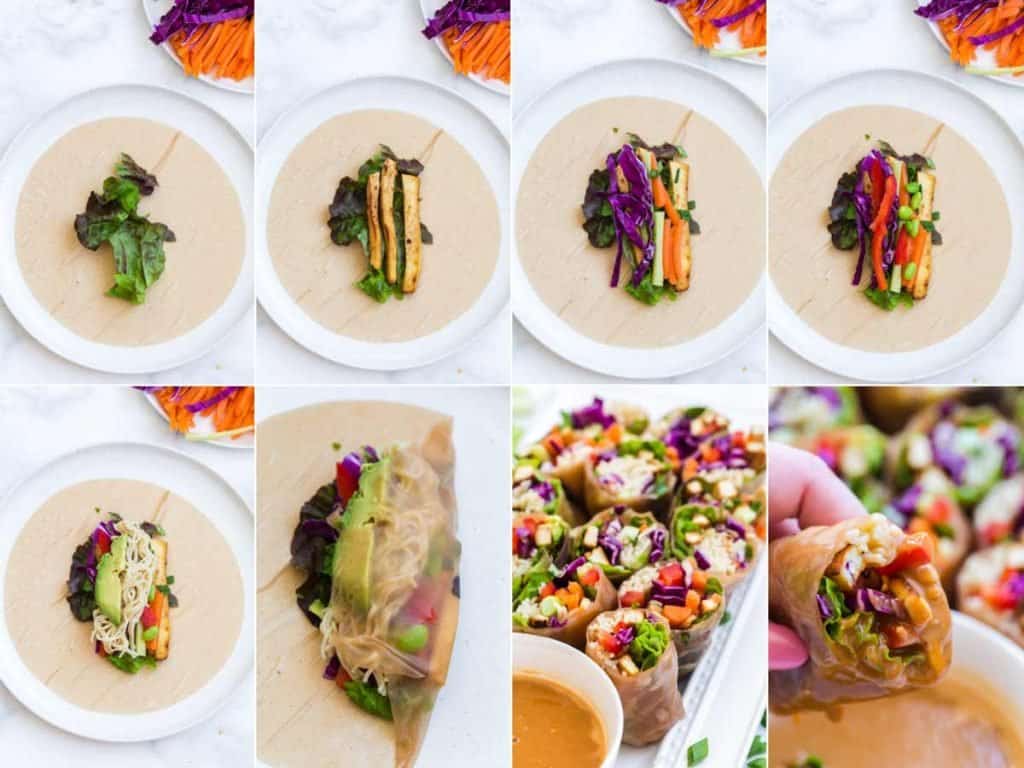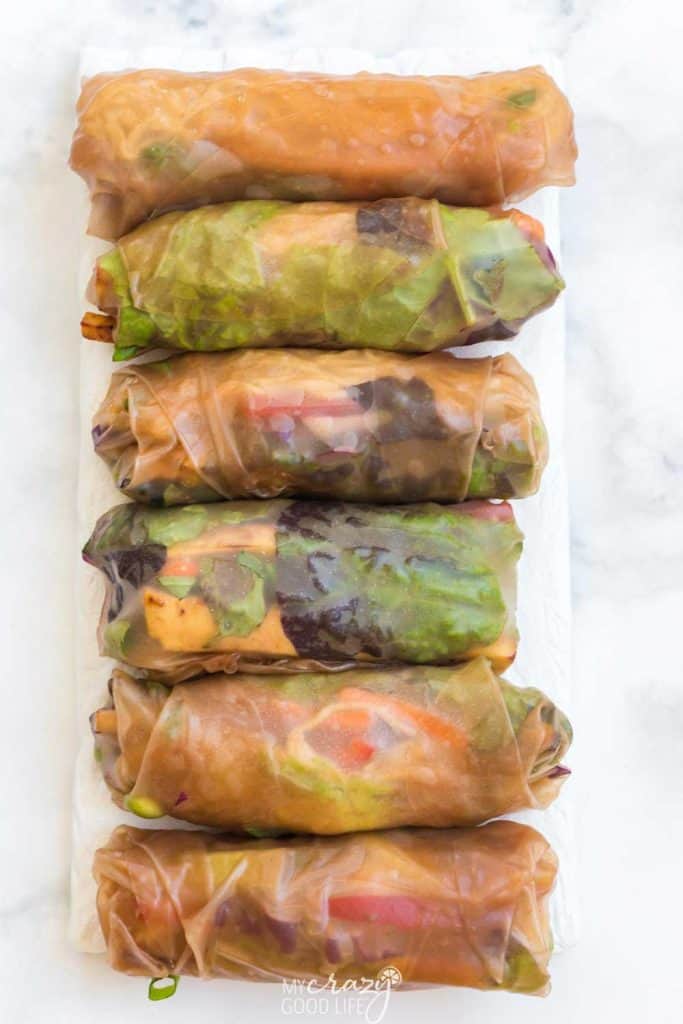This site contains affiliate links. Please see Policies for more information.
I love veggie spring rolls and I have finally found a way to easily make them at home. These homemade spring rolls are light and refreshing, and great for summer days when you don’t want to heat the house by turning on the oven.
Similar to egg rolls, you can find spring or summer rolls in Asian cuisine. This recipe is not fried, though! It’s a brown rice wrapped roll stuffed with healthy, raw vegetables and served with an amazing peanut dipping sauce that you are going to love.

Where’s the recipe?
Here at My Crazy Good Life, we want cooks of all levels to feel comfortable and confident making our recipes. To achieve that, we like to provide lots of helpful information in our posts. In the article below you’ll find ingredient information, tips on how to wrap spring rolls, plus healthy eating plan calculations.
If you’ve ever wondered how to make summer rolls, just keep on reading below for all of the information you’ll need. If you’re comfortable in the kitchen and want to get right to the recipe, you can scroll to the bottom of the page where you’ll find the easy to print recipe for these delicious Vegetable Spring Rolls.

Ingredients for this Fresh Spring Rolls Recipe:
Base Recipe for Veggie Spring Rolls (you’ll need all of these ingredients)
- Rice paper wrappers: I like to buy brown rice spring roll wrappers because they’re less processed than white rice and have less ingredients than traditional rice paper wrappers. If all you can find is the white ones, that’s ok!
- Lettuce: leafy green or red leaf lettuce is what I use.
- Fresh basil: please get fresh basil for this recipe! I’ve tried to use dried basil and it doesn’t compare.
- Green onions: thinly sliced green onions add great flavor to the rolls.
- Purple cabbage: purple or red cabbage gives these rolls a beautiful color.
- Carrots: carrots add a variety of nutrients and the orange color adds to the beauty of these colorful rolls.
- Brown rice ramen: again, I like to use brown rice noodles because they’re a bit less processed than other rice noodles-they’re also whole grain and help you stay full for longer. You can use vermicelli noodles or traditional ramen noodles if you prefer.
Optional ingredients (I’d recommend using 2-3 of these)
- Jicama: jicama is another crunchy, mellow tasting vegetable that is a wonderful addition to veggie spring rolls.
- Cucumber: cucumbers have a nice mellow flavor and also add a boost of important vitamins and minerals.
- Air fried tofu: if you’re craving some protein but want to make vegan spring rolls, you can add tofu. I love air frying the tofu first after marinating with homemade teriyaki sauce!
- Avocado provides a creamy texture and healthy fat.
- Red bell pepper: bell peppers are a great source of vitamin C. I like adding red peppers but any color will do if you prefer another.
- Edamame: adding edamame beans is another great vegan protein option.
Dipping sauce ingredients:
This dipping sauce doesn’t contain brown sugar or highly processed oils. You can feel good about using it!
- Coconut aminos: coconut aminos are a healthy soy sauce or fish sauce substitute. If you can’t find coconut aminos, low sodium soy sauce or tamari will work.
- Peanut butter: you’ll want to use creamy peanut butter or almond butter.
- Maple syrup: I love using pure maple syrup as a sweetener. Other store bought sauces (like hoisin sauce) can use refined sugars, which I try to avoid.
- Sriracha or chili paste: sriracha is a uniquely flavored hot sauce that you’ll find in a lot of Asian recipes.
- Roasted sesame oil: using roasted (or toasted) sesame seed oil adds umami to this peanut sauce for spring rolls.

How to make Veggie Spring Rolls
- Get out your cutting board and start thinly slicing your filling ingredients. Add them to bowls or plates so you can quickly make your rolls later.
- Cook your ramen according to package directions. After the ramen is cooked, I like to drizzle some roasted sesame oil on them to keep them from sticking. The flavor is delicious, as well.
- Follow the directions on your rice paper wrappers to soften them. This will usually involve dipping the rice paper into water and making the rolls one at a time.
- Once your wrapper is soft, you can start to build your summer roll.
- Place one wrapper down on a clean flat surface and start filling the center of it with your vegetables. I like to start with the lettuce, leaving space on the sides for rolling, then place all the other veggies directly on top.
- When you’ve added all of your filling, take one side of the wrapper and fold it over the filling, then take the other two sides, one at a time, and tightly roll it together. There are step by step pictures below to help you do this.
- If you’d like, you can double wrap your summer rolls by softening another wrapper and placing it tightly around the original roll.
- Once you have assembled all of your veggie spring rolls, set the finished rolls aside and start making your easy peanut sauce.
- In a small bowl or mason jar, mix together the coconut aminos, peanut butter, maple syrup, sriracha, and sesame oil. I like to shake the mason jar well before serving.
- Serve the rolls whole, or cut them in half to show off the colorful ingredients.

Recipe tips
- I don’t usually make springs rolls much in advance, because the wrappers can harden both in the fridge as well as on the counter. But you can prep and store the filling ingredients and peanut sauce in the fridge ahead of time. Then, when you’re ready to serve, you can soften the wraps and assemble with the pre-sliced veggies.
- It’s worth repeating: use fresh herbs. I love using basil, but fresh mint or cilantro would be lovely as well.
- If you’re like me and have a tendency to overstuff, you don’t want to do that here. The rice paper is forgiving but it is also thin. So, try and hold back when stuffing the wraps. After the first few you’ll get the hang of how much filling to add.
- Veggie spring rolls are super easy to customize. You usually will want crunchy, thinly sliced veggies, some type of noodle, and possibly a protein. If you’re not a fan of tofu, shrimp or pork works well too!
- The rice paper wrappers are very thin and can be hard to work with. You’ll want to gently wrap the filling without tearing the wrapper. If you do get a large tear you can double wrap your roll to contain the filling.
- Have extra ingredients? Make a stir fry with the veggies (leave the avocado out of the pan), add the ramen to reheat, and top with the sauce for a delicious dinner.
- If you have leftover rolls, you can use some plastic wrap to individually wrap the rolls. Leave them on the counter, then open and run quickly under a stream of water before eating. This isn’t the best recipe to have leftovers for, but I also don’t like wasting food.

Double wrapping the spring rolls:

Healthy Eating Plans
- For the 2023 WW Points Plan, the spring rolls are 4 points each – this is for the brown rice wrapper and brown rice ramen. The recipe for the sauce will leave you with some leftover so I divided that into 8 servings for this recipe – each serving of sauce is 2 points.
- For Portion Fix/21 Day Fix, I’ve found it easiest to fill my green container with toppings and use about 1/2 cup of toppings for each roll. I have never been able to add a full red container of protein to the rolls, so I roll with it and eyeball my portions. Typically, I can get 1 red container of protein (3/4 cup) into every 3 rolls.
- The brown rice wrappers have 62 calories for every 2, which puts them right at 4 wrappers for 1 yellow container.
- Using the guidelines above, each roll would be about 1/2 green container, 1/3 red container, and 1/2 yellow container. Remember, yellow container is 1/2 cup, red container is 3/4 cup, and green container is 1 cup.
- For 2B Mindset, this recipe is a perfect lunch when you add protein to each roll. Remember, you’re aiming for 50% veggies, 25% FFC, and 25% protein.

More Healthy Asian Recipes
- Teriyaki Tofu Stir Fry Bowls
- Instant Pot Chicken Lo Mein
- Instant Pot Miso Soup with Mushrooms
- Instant Pot Beef Pho Recipe
- Instant Pot Egg Drop Soup
- Healthy Egg Roll Cups
- Instant Pot Tofu Pad Thai

Fresh Veggie Spring Rolls
Equipment
- Brown Rice Wrappers
- Cutting Board
- Kitchen Knife
Ingredients
Base recipe:
- 8 Brown rice paper wrappers white will do in a pinch!
- 4 leaves Leafy green or red lettuce
- 8 leaves Fresh basil thinly sliced
- 2 stalks Green onions thinly sliced
- 1/2 cup Purple cabbage thinly sliced
- 1/2 Cucumber peeled and thinly sliced
- 2 cakes Brown rice ramen cooked according to package directions
Optional (all of these ingredients won't fit into the wrappers, so choose 2-4 in addition to base recipe):
- 1/2 cup Jicama peeled and thinly sliced
- 1 Carrot peeled and thinly sliced
- 1/2 cube Air fried tofu thinly sliced
- 1/4 Avocado thinly sliced
- 1/2 Red bell pepper thinly sliced
- 1/4 cup Edamame shelled
Peanut sauce:
- 1/2 cup Coconut aminos or low sodium soy sauce/tamari
- 1/4 cup Creamy peanut butter
- 1 tsp Maple syrup
- 3 tsp Sriracha or chili paste (optional)
- 3 tsp Roasted sesame seed oil
Instructions
- Get out your cutting board and start thinly slicing your filling ingredients.
- Cook ramen noodles according to package directions
- Follow the directions on your rice paper wrappers to soften them. This will usually involve dipping the rice paper into water.
- Once your first wrapper is soft you can start to fill your summer/spring roll.
- Place one wrapper down and start filling the center of it with your vegetables. I like to start with the lettuce, leaving space for rolling, then place all the other veggies directly on top.
- When you've added all of your filling, take one side of the wrapper and fold it over the filling, then take the other two sides, one at a time, and tightly roll it together.
- If you'd like you can double wrap your roll by softening another wrapper and placing it tightly around the original roll.
- Once you have assembled all of your spring rolls, set the finished rolls aside and start making your easy peanut sauce.
- In a small bowl or mason jar, mix together the coconut aminos, peanut butter, maple syrup, sriracha, and sesame oil.
- Serve the rolls whole or cut them in half to show off the colorful ingredients.
Notes
- I don’t usually make springs rolls much in advance, because the wrappers can harden both in the fridge as well as on the counter. But you can prep and store the filling ingredients and peanut sauce in the fridge ahead of time. Then, when you’re ready to serve, you can soften the wraps and assemble with the pre-sliced veggies.
- It’s worth repeating: use fresh herbs. I love using basil, but fresh mint or cilantro would be lovely as well.
- If you’re like me and have a tendency to overstuff, you don’t want to do that here. The rice paper is forgiving but it is also thin. So, try and hold back when stuffing the wraps. After the first few you’ll get the hang of how much filling to add.
- Veggie spring rolls are super easy to customize. You usually will want crunchy, thinly sliced veggies, some type of noodle, and possibly a protein. If you’re not a fan of tofu, shrimp or pork works well too!
- The rice paper wrappers are very thin and can be hard to work with. You’ll want to gently wrap the filling without tearing the wrapper. If you do get a large tear you can double wrap your roll to contain the filling.
- Have extra ingredients? Make a stir fry with the veggies (leave the avocado out of the pan), add the ramen to reheat, and top with the sauce for a delicious dinner.
- If you have leftover rolls, you can use some plastic wrap to individually wrap the rolls. Leave them on the counter, then open and run quickly under a stream of water before eating. This isn’t the best recipe to have leftovers for, but I also don’t like wasting food.
- For the 2023 WW Points Plan, the spring rolls are 4 points each – this is for the brown rice wrapper and brown rice ramen. The recipe for the sauce will leave you with some leftover so I divided that into 8 servings for this recipe – each serving of sauce is 2 points.
- For Portion Fix/21 Day Fix, I’ve found it easiest to fill my green container with toppings and use about 1/2 cup of toppings for each roll. I have never been able to add a full red container of protein to the rolls, so I roll with it and eyeball my portions. Typically, I can get 1 red container of protein (3/4 cup) into every 3 rolls.
- The brown rice wrappers have 62 calories for every 2, which puts them right at 4 wrappers for 1 yellow container.
- Using the guidelines above, each roll would be about 1/2 green container, 1/3 red container, and 1/2 yellow container. Remember, yellow container is 1/2 cup, red container is 3/4 cup, and green container is 1 cup.
- For 2B Mindset, this recipe is a perfect lunch when you add protein to each roll. Remember, you’re aiming for 50% veggies, 25% FFC, and 25% protein.
Nutrition
Make This Recipe?
Make sure to follow on Pinterest @bludlum and on Instagram @beccaludlum
































Did you love this recipe?
Make sure to comment below so we can chat about it! Or follow on your favorite social network for even more family recipes.